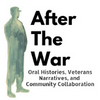Digital History and After the War
Introduction
A bus comes to a creaky stop. The relentless Seattle rain beats on the roof while soldiers grab their olive duffle bags from below. Depending upon the year, some may light a cigarette and take a long drag while ignoring the rain; even relishing in it. Others may move cautiously, mindful of new pains. And others may run from the bus covering their face from the jeers hurled painfully at them.
The year could be 1918, 1945, 1951, 1968, 1998, or 2008. Whether returning from European theaters of war, thick jungles of Vietnam and southeast Asia, or the sandy expanses and craggy mountains of the Middle East, U.S. Army soldiers returning to Fort Lewis just outside of Seattle, Washington since World War I have had to navigate life after the war. They, like every other person who served in a branch of the U.S. military and survived tours of duty, are united in this experience. But that navigation varies drastically.
The Harlem Hellfighters, the all Black and soldier-of-color regiment that fought in the trenches of France, became heroes of the First World War and received a segregated welcome back to the United States, only to endure the domestic terrorism of the Red Summer of 1919. Some World War II veterans returned to ticker tape parades and heroes' welcomes, others to abject racism. Soldiers and military members drafted into the War in Vietnam faced vitriol and blame. Yellow ribbons flew from trees, flag posts, and lapels across the United States to show support of the people who served in the military during the early aughts.
However, these well-known scenarios reflect the social and cultural response of citizens, not necessarily the veterans themselves.
- How did veterans navigate these experiences?
- What did they see, do, and overcome after the war?
- How deep are the roots of the "Double V" campaign?
- Is the “Double V” campaign of the 1940s still ongoing?
- How can a nation with a modern tradition of perpetual military “conflicts” better support the people that served in those campaigns?
- Even if veterans move through the same place, is it the same space? It is in these questions that the topic for this proposed community driven digital history project can be found.
Using the medium of digital history, this project seeks to present and uplift the histories of veterans- especially Black and veterans of color- return from war and transition to civilian life.
Using this exhibit
This exhibit presents the view that the voices and perspectives of historical actors should be the center of a public digital history project; that statistics and data visualizations alone are not enough to "see," "hear," or fully contextualize history from the "bottom up."
But, this is also an experimental space.
You'll see how different applications of digital history can yield different views into the history. As you click through the pages, you will get a glimpse into the process, have opportunities to "play" with some of the digital history tools, and browse the resources that informed this project.
To navigate forward to the next page or backwards to the previous one, click on the "next" in the bottom right corner or "prev" (for previous) in the bottom left corner.
You are also welcome to use the drop down menu in the upper right corner of the screen to navigate through the exhibit.

